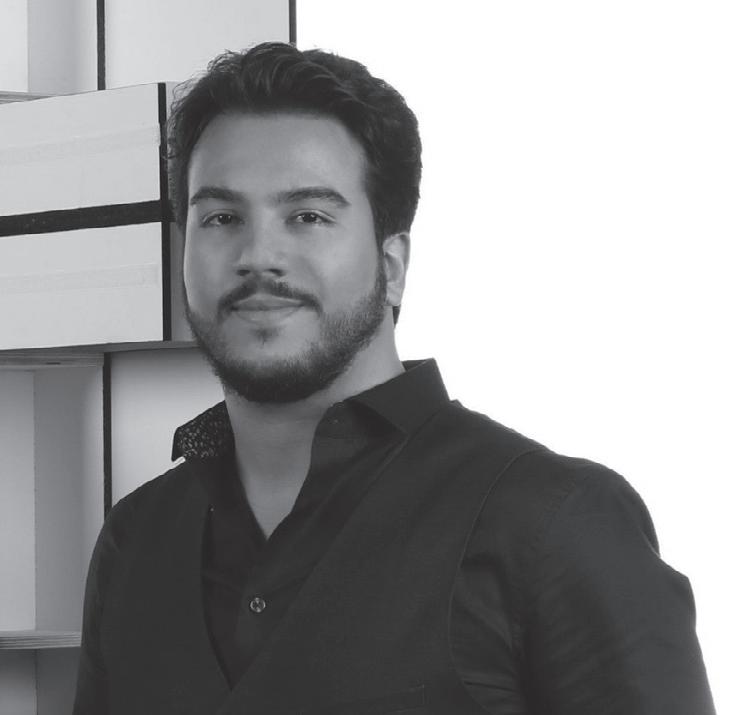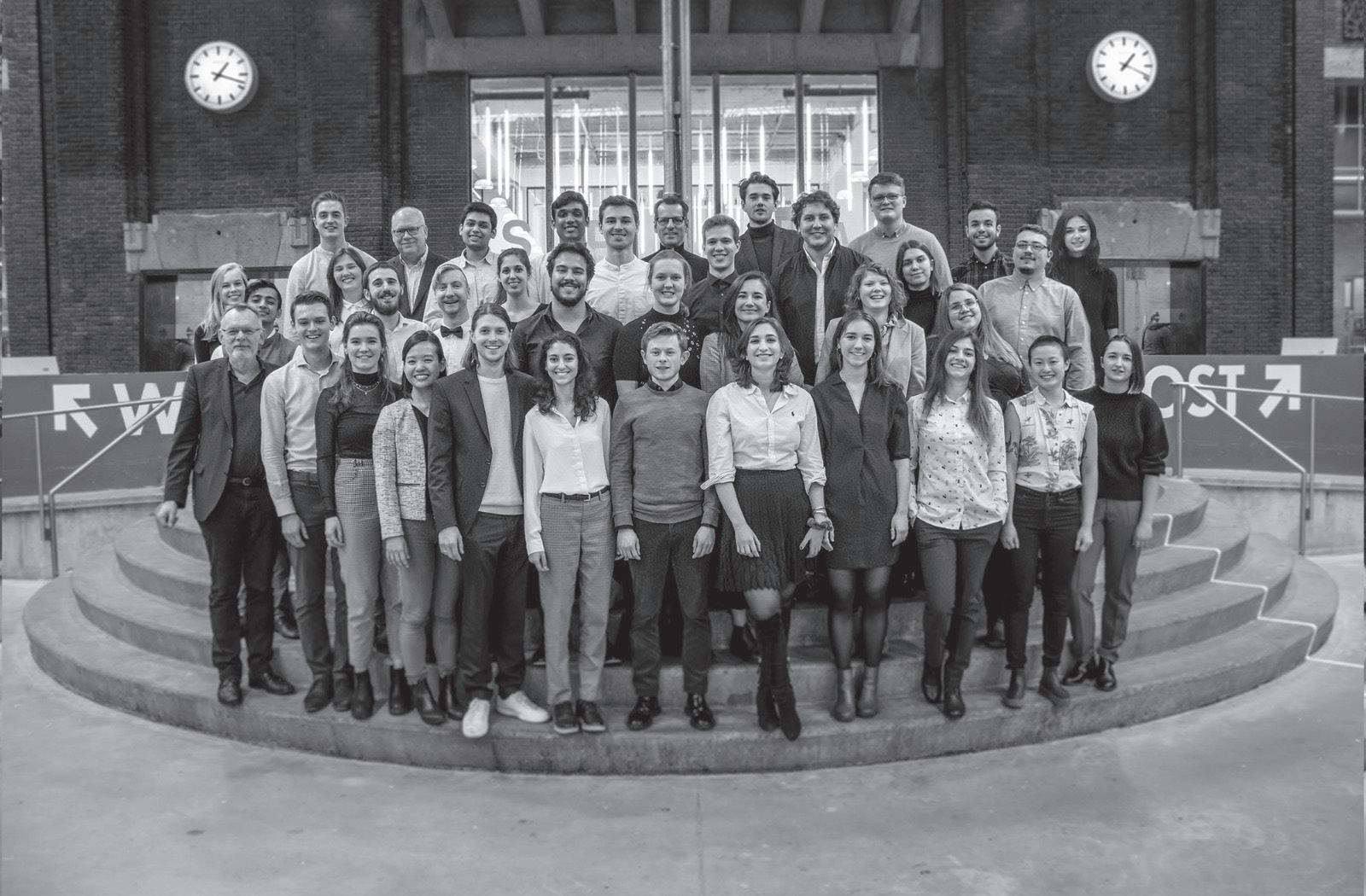
7 minute read
SUM

Team SUM
Advertisement
Danny: From the Netherlands. Master of Architecture since September 2019. Discipline: Communication & Branding. Adriano: From Chili. Master of Architecture & Engineering since August 2019. Discipline: Architecture. Team expert on solar integration & circularity.
In the last edition about Abstraction I interviewed Thomas Rau about circularity in the architectural world. He stated that students can ‘forget everything they learnt’ when they would show up at his architectural firm. I wanted to get another perspective on this subject and decided to interview two members of the SUM team. They are going to participate in the Solar Decathlon 2022, during which they will create a circular design. How will they do this and what is their opinion on circularity?
You started with six people during the summer, and now you are growing by the day. Consisting of 42 committee members today, what does this start-up phase look like?
Danny: “In September we started with the concept.
We wanted to make clear our vision on this competition. At the moment, we are focusing on brainstorming and creating the first drawings. We are doing a lot of research and case studies as well.
We have a lot of meetings in which we discuss this research of all the disciplines. We are not only learning what we want to design, but also how to work together as a team. Our team consists of 42 people with 15 different nationalities and backgrounds. We all have our own experiences. By combining all those experiences, we want to come up with the best plan possible.”
Working together as a team must be hard with so many people. You consist of disciplines that differ from Communication & Branding to Engineering and Partners & Budget. How do you keep those disciplines in balance?
Danny: “I think integrating these disciplines will be one of the greatest challenges. It is even more difficult since we are fully working online due to the corona crisis. Communication is key, in my opinion.
This is quite a challenge because we want to create a solution not only for the competition, but for the challenges we are facing today and in the future. The first major challenge is that we will have to create a climate-neutral economy by 2050, according to the Paris agreement. The other challenge we face is the population growth. We need to build a million new houses before 2030. That is why we looked for an area in the Netherlands with those two challenges in mind.” Adriano: “Yes, our main goal is to find the biggest challenges and to find the most sustainable solutions for the maximum amount of cases possible.”
“We definitely don’t want to find the most comfortable building example for us to develop; we want to find the most adaptable solution in order to establish the biggest impact in the Netherlands. ”
So that is the reason you started looking at tenement flats in The Hague.
Adriano: “Exactly. It is also important to realize that we are not building something new. All the buildings we are looking at are post-war buildings and we are trying to find a way to renovate them. When you create a new building, you waste a lot of energy in the process. When you renovate efficiently by using the existing embodied energy of the materials, you are adding less carbon emissions to the process of design, manufacturing, transportation and construction.”
It sounds to me like you have a lot of things to think through. What are the parts of the competition you are looking forward to the most?
Danny: “For me it is building the prototype, scale 1:1.
We will take out a fragment of the building and put it on the site. First, we will build it in the Netherlands, and then shift it to Wuppertal (where the competition takes place) and build it again. That will be really challenging but fun, I think.”
Adriano: “Creating a real solution, a product. We need to make a product that can serve the market; that is modular, flexible and easy to assemble. Hopefully, we can create guidelines for other companies as well.”
That would be beautiful. As you mentioned, a huge aspect of this competition is reducing energy, but also circularity plays a considerable role. How do you think the competition can be renewing, when speaking about circularity?
Adriano: “The competition is expanding towards the urban aspect. This adds a different perspective on circularity; it includes transportation and other approaches that go beyond the building. We want to educate the residents as well.”
And how do you think you can educate the residents about circularity?
Adriano: “Now, we are evaluating all the parameters and existing conditions of the materials and the
1,000,000 CO2 New Construction
Image 1: Infographic SUM components. We want to diminish the CO2 footprint. By doing that, we create a material passport.” Danny: “Normally, the material passports are only available for the developer or architect, but we want to share it with the residents. By sharing it, they learn and know what their walls are made of and they will become more conscious about the circular economy. We want to create a whole movement so we can shift towards a circular economy for our world.”
The idea of a material passport comes from architect Thomas Rau, who I interviewed in the last edition. It was a special interview to me, partly because of his radical statements. In one of them he considers that sustainability has nothing to do with circularity and that sustainability only consists of ‘repairing the system’. What is your opinion on that?
Adriano: “I understand what he says. My opinion is that sustainability is more about adaptability instead of repairing. We believe that circularity contributes to a more sustainable future. Materials are the essence.
The buildings that we are looking at were built a long time ago, and in that time they were okay for their standards. But today we are more aware and conscious about our relationship with the Earth and we know that the way that we managed our built environment has been detrimental for a long time.
Therefore, we need to adapt.”
Danny: “Indeed, we are not fixing what is broken; we
by 2030
new homes
-50%
874,000
TENEMENT FLATS current plan label <C team sum
Demolition Renovation
need to relearn how to live.”
Extension
CO2/m2
New Construction
Renovation + Extension
Renovation 0
current plan
team sum
80-120 years
Figure Material & Energy Global Warming potential

Image 2: Team SUM
That is another beautiful thought, I think. Since this edition of pantheon// focuses on the Detail, what is your opinion about the detail being a part of a design?
Danny: “There are two different types of details.
The first one is when you base your concept on a certain detail. For example, if your goal is to design and develop a modular building based on a wooden connection, the detail plays a major part in the design. That is different from a detail that is added to an already existing concept.”
Adriano: “Indeed, then the details bring life to the concept. I think that good detailing adds quality to the end product.”
And what do you think about your education? Rau stated that the universities completely fall behind if you look at circularity. Do you agree on this?
Adriano: “In most universities, circularity is a new thing. They give you the guidelines, but in the end you can choose how to design. However, we will have to shift from a linear economy towards a circular one.
It should be compulsory at some point, to design with circularity in mind.”
Danny: “I think our faculty is doing a great job in circularity; we are shifting towards it. But if you look at the design projects, it is not a compulsory part to create a material passport and you get the freedom as a student to choose a topic you prefer. I think it is great to have this freedom, but it would be a good idea to get a grade for topics such as circularity or solar integration somewhere during your education.
That would be the perfect balance.” And that is all we are looking for in the end, a perfect balance.
Adriano: “Yes. While doing that, I believe all students must think and act with sustainability in mind.
We have one planet, and it is our responsibility to approach the built environment in the most efficient way.”
Danny: “Indeed. And if you think you want to contribute and make that step to a more sustainable world, the Solar Decathlon Europe 2022 Competition is a great opportunity for you. By designing and developing the building in real life you learn so much.
Together we will search for solutions that contribute to a positive urban and social living environment; we will create future-proof communities that are based on sustainable habits. Join our Symbiotic Urban
Movement!” //










